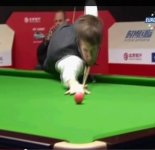I have noticed Judd Trump using a swipe variation of Back Hand English quite a few times, particularly on screw shots when reversing off the rail, as snooker players refer to it.
Here's an example, in shot 3 of this video at around 52 seconds. The link should take you straight to it.
https://youtu.be/0PlhkHVgqss?t=52s
I photoshopped the image below which shows his alignment prior to backswing his alignment just prior to hitting the CB. There is a significant pivot into his body with the back hand.
Note that his initial alignment is pretty much spot on for a draw shot without any side english.
While he swipes, I've noticed that on these firm shots, the swipe has negligible effect on the application of BHE.
I doubt he is aware of BHE, but he and some other players discover this method for certain shots.
Colin
Here's an example, in shot 3 of this video at around 52 seconds. The link should take you straight to it.
https://youtu.be/0PlhkHVgqss?t=52s
I photoshopped the image below which shows his alignment prior to backswing his alignment just prior to hitting the CB. There is a significant pivot into his body with the back hand.
Note that his initial alignment is pretty much spot on for a draw shot without any side english.
While he swipes, I've noticed that on these firm shots, the swipe has negligible effect on the application of BHE.
I doubt he is aware of BHE, but he and some other players discover this method for certain shots.
Colin
